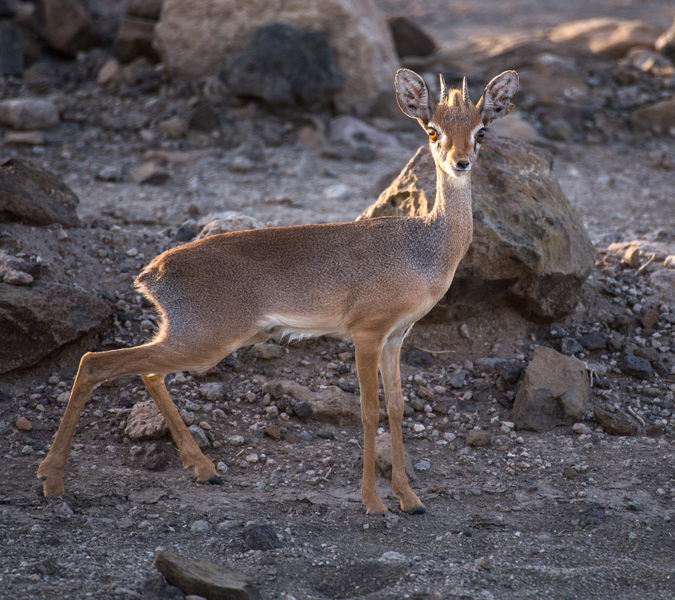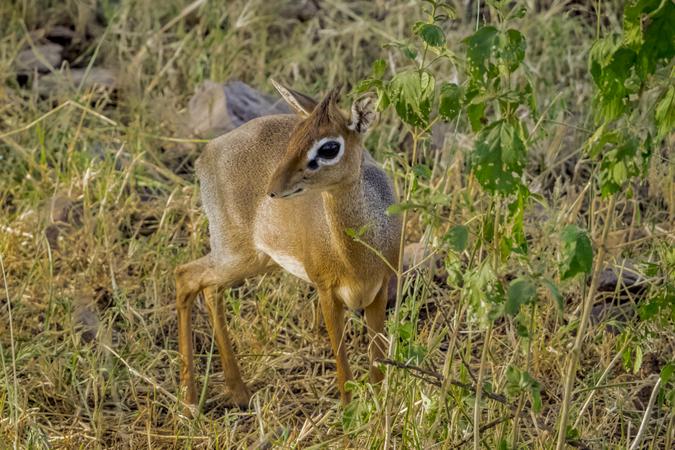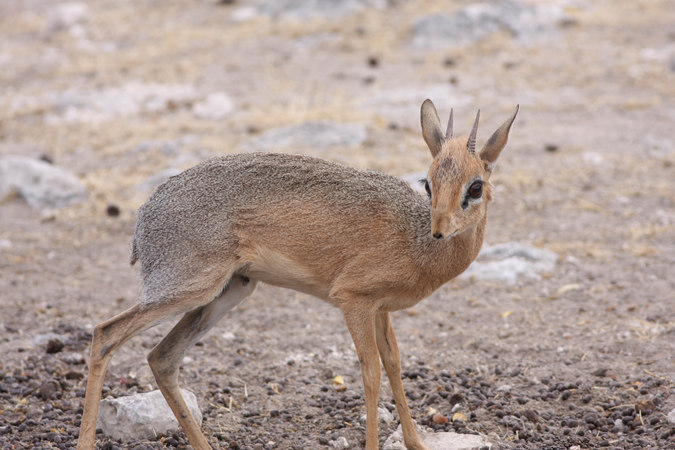
Damara dik-dik © Yathin S Krishnappa/WikiCommons
Written by Craig Glatthaar
The moment it sounded like I had stood on a dog’s chew toy I knew that our search was coming to a close. I was in the northwestern corner of Namibia, in Damaraland, searching for a strange-looking antelope (that makes weak, squeaky sounds). Damaraland is an area characterised by flat-topped mountains, dramatic wind-sculpted sandstone cliffs, broad valleys and dry riverbeds that carve their way through deep, ancient gorges. The seemingly barren surroundings, with little human presence, immediately makes one question if anything can survive out here. That question can be answered by one little guy, who not only survives here, but thrives in this desolate landscape – the tongue twister antelope known as a Damaraland dik-dik (Madoqua kirkii damarensis).
The name comes from the unusual alarm call that the females commonly makes, which sounds like a wheezing and whistling “zik-zik” or “dik-dik”. These antelopes were called “dik-diks” by the early settlers and hunters as they ruined the hunter’s chances of shooting any larger game thanks to their alarm calls.
These lovely little ungulates live in both southern and eastern Africa and there are four recognised species (with a few subspecies) that belong to the Madoqua genera. Their unusual appearance and behaviour is supremely suited to the dry Damaraland of Namibia (home to the Damaraland dik-dik – an isolated population of Kirk’s dik-dik, though different enough genetically to be considered a different species), and the semi-arid shrublands of East Africa, where you’ll find the Salt’s, silver, Günther’s and Kirk’s dik-dik. The Kirk’s dik-dik has three distinct species (Kirk’s, Naivasha, and Ugogo).

Salt’s dik dik © David Castor/WikiCommons
Here are five curious facts that make them an exciting case for evolutionary study:
• All of the species depend upon low-level thickets and succulents and are very habitat specific, moving to more arid areas if local changes encourage dense or tall grass to colonise the area.
• Their size, being very small but long-legged antelope (2-7 kg in weight and 35-65cm at the shoulder), makes them particularly vulnerable to a number of predators. For this reason, they have developed this unique alarm call that gives the antelope their name and will often call in tandem to confuse predators. When frightened, they will run in a zig-zag pattern into the nearest thicket, hitting speeds in excess of 40km/h.

Damara dik-dik © Winfried Bruenken/WikiCommons
• They’re monogamous, with males and females spending about 65% of their time together. This monogamous lifestyle probably evolved out of the potential danger from moving around looking for mates. The female gestates for 169 to 174 days and at the start (or finish) of the rainy season, bears a single offspring. The offspring is forced out of its parents’ territory when they reach full adult size at around seven months old, which usually coincides with the female’s next pregnancy. The mothers chase off female offspring, and the fathers chase off male offspring.
• Dik-diks mark their territories with tears, or preorbital glandular fluid. This comes from the black spot in the corner of their eyes. Dik-diks bury their heads in grass, poking their eyes with it to spread the sticky secretion to mark their territory. They’ll also use communal middens to build up a sizeable heap of dung. Some have been seen dropping their dung on top of elephant dung, possibly for gained elevation or maybe in a show of over-eager bravado.

Günther’s dik-dik © Esin Üstün/WikiCommons
• The dik-dik’s short and hairy proboscis, with slit-like nostrils, is an enlarged nasal chamber richly supplied with blood that is cooled efficiently through rapid nasal panting, with minimal loss of water in the exhaled air. This, together with other water- and energy-conserving measures – fluctuating body temperature, lowering the metabolic rate, and nocturnal activity – as well as highly selective browsing on foliage and succulents, means they survive incredibly well in arid regions.
So, when you next visit the spectacular region of Damaraland in Namibia, be sure to look out for the very uniquely adapted and strange sounding dik-dik.

Damara dik-dik © Ron Knight/WikiCommons


